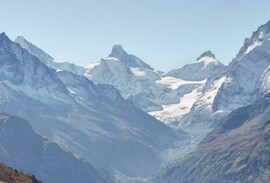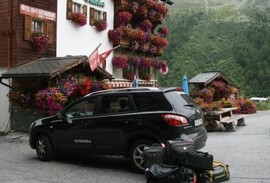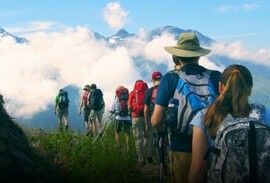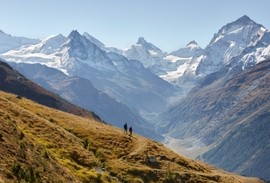- Trips
- Tour Calendar
- About Our Tours
- Plan a Trip
- Book a Trip
- About Us
- Contact Us

Haute Route FAQ
Common Questions about the most scenic trek in Europe
- What's it like to hike the Haute Route on an Alpenwild guided tour?
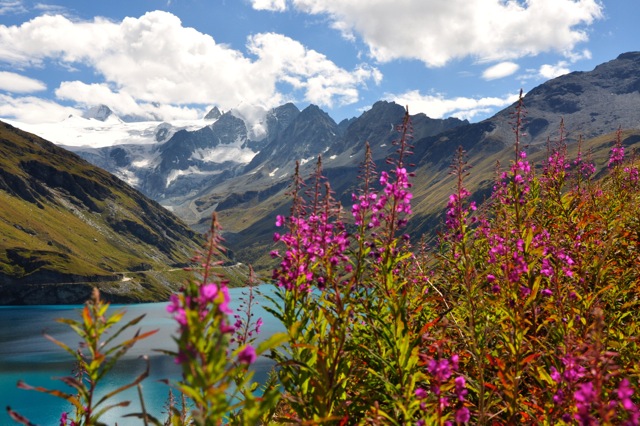
- Do I need prior hiking experience?
- Do I have to carry everything on my back?
- What does "BSD" mean in the itinerary?
- Does the Haute Route require technical climbing skills?
- Which Haute Route trips include stays in mountain huts?
- How many miles per day do we walk?
- What about luggage when we're in the huts?
- What is the typical group size?
- What's the difference between walking, hiking and trekking?
- Should I purify water on the Haute Route?
- Where can I change money?
- I live in Florida. Will I have a hard time with the altitude?
- I've never really done much in the way of hiking or outdoor adventure. Will I be able to keep up?
- What is the pace on the Haute Route?
- What gear do I need to bring? What group gear do you provide?
- I'm a vegetarian. Can you accommodate special dietary needs?
- Which airport should I fly into for the Haute Route?
- What is a Single Supplement?
Here are some of the most common questions we hear as we talk with people making plans for the Haute Route, but we love entertaining new questions and very specific personal questions. Please feel free to call or email and give us your best shot.
What's it like to hike the Haute Route on an Alpenwild guided tour?
Hiking on the Haute Route with Alpenwild is the trip of a lifetime. It's the most scenic trek in Europe and no other outfitter, guide service, or tour operator has more experience on the Haute Route. As a result you'll benefit from hiking with the most experienced guides on the Haute Route and you'll enjoy a level of quality and range of services not found on other trips. Like our other Alps hiking and walking trips, our Haute Route treks are built on a philosophy that the best and most enjoyable way to discover the Alps is on foot, with a small group of friends, and in the company of someone who knows and loves these gorgeous mountains and valleys. As a result, our clients are really guests and friends, and we find that they develop wonderful friendships along the way. Our programs are also wonderful learning and growth experiences so that you return richer, stronger, and wiser. Our goal for all guests is threefold (in this order) 1. Be safe 2. Have a great time and 3. Do your best. 
Do I need prior hiking experience?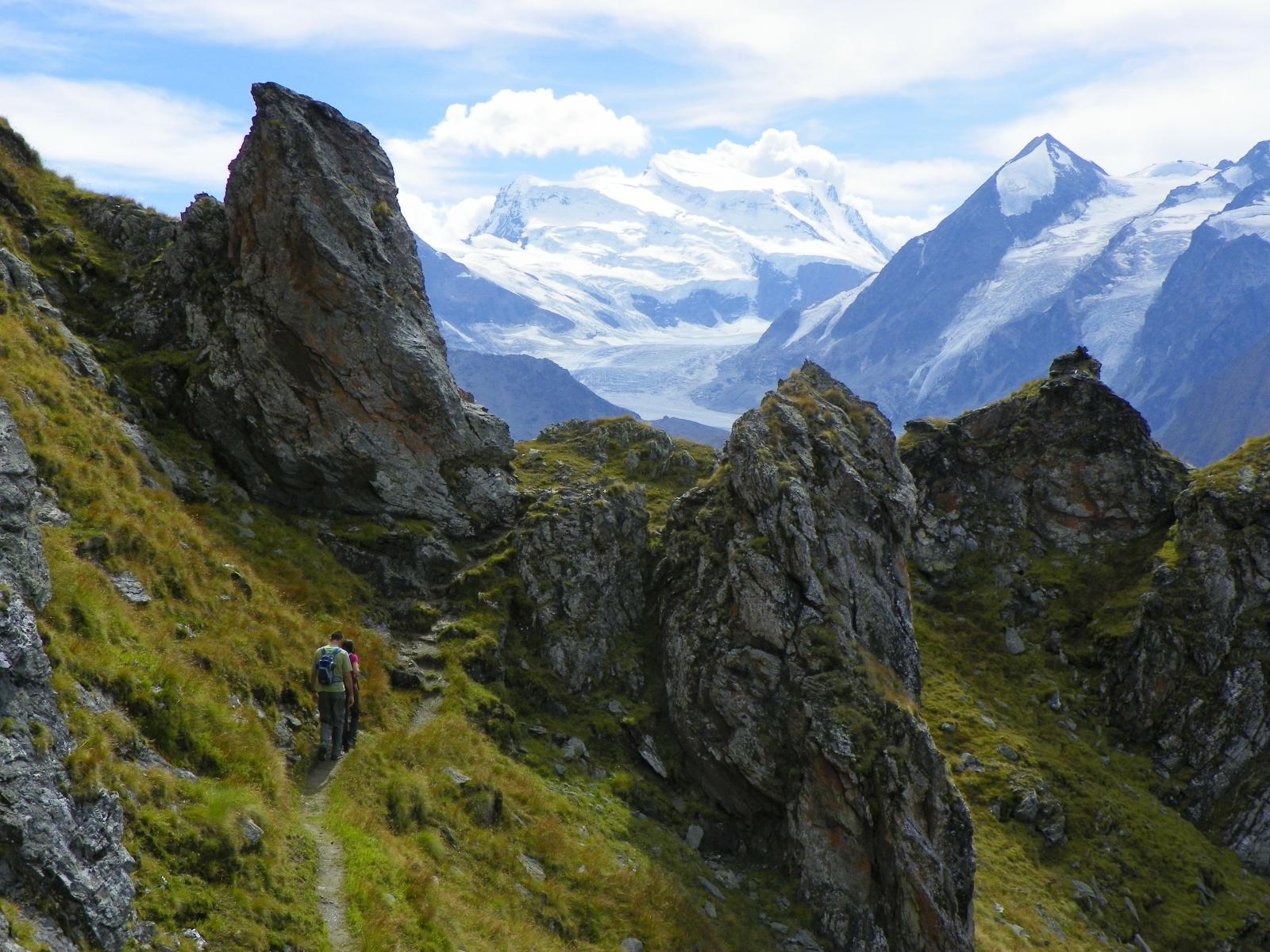
The Alps is the greatest hiking destination in the world, and it's also one of the most varied and adaptable. Even if you've never hiked outside of your own area, you can have a dream vacation hiking in the Swiss Alps. You should be in good health and have some solid hiking experience. You should have some experience with daily vertical ascents of 3000-4000 feet. The Haute Route is one of our more challenging treks and as an experienced and fit hiker you'll certainly enjoy the trip more. 
Do I have to carry everything on my back?
We provide luggage transfers on all of our treks and inn-to-inn tours, so you can walk with just the items you need, knowing that your luggage will be waiting for you at the hotel when you arrive. On the Haute Route, you won't have access to your luggage while in the huts; but after your hut stay, you arrive at a hotel knowing that your bags will be there waiting for you. 
What does "BSD" mean in the itinerary?
It means that a Breakfast, Snack, and Dinner are all included in the tour price. Each day you'll have a full Swiss breakfast at your hotel or mountain hut. While we're walking in the mountains or out during the day, we're not often near a place where we can stop for a lunch-besides most people don't want to hang around a restaurant ordering and waiting for food, when they could be out enjoying the Alps. So we provide trail snacks and we generally stop around lunchtime for a wonderful mountain picnic which often includes fresh bread, local cheese purchased on the alp, sausage or traditional air-cured meats, fruit, chocolate and other local treats. It's always a highlight, and no one goes hungry. Most other outfitters would call this a "lunch," but since it's not a sit-down restaurant meal, we call it a "snack" Dinners in the huts are filling and well prepared, while in the towns and villages we seek out the best restaurants or hotels available-with an emphasis on small, locally-owned restaurants and traditional cuisine-and the food is exquisite. Many guests rave about the quality of the dining experience, plus it's a great time to socialize, meet the locals, and share stories of the day's highlights. 
Is it appropriate to tip the Trip Leader?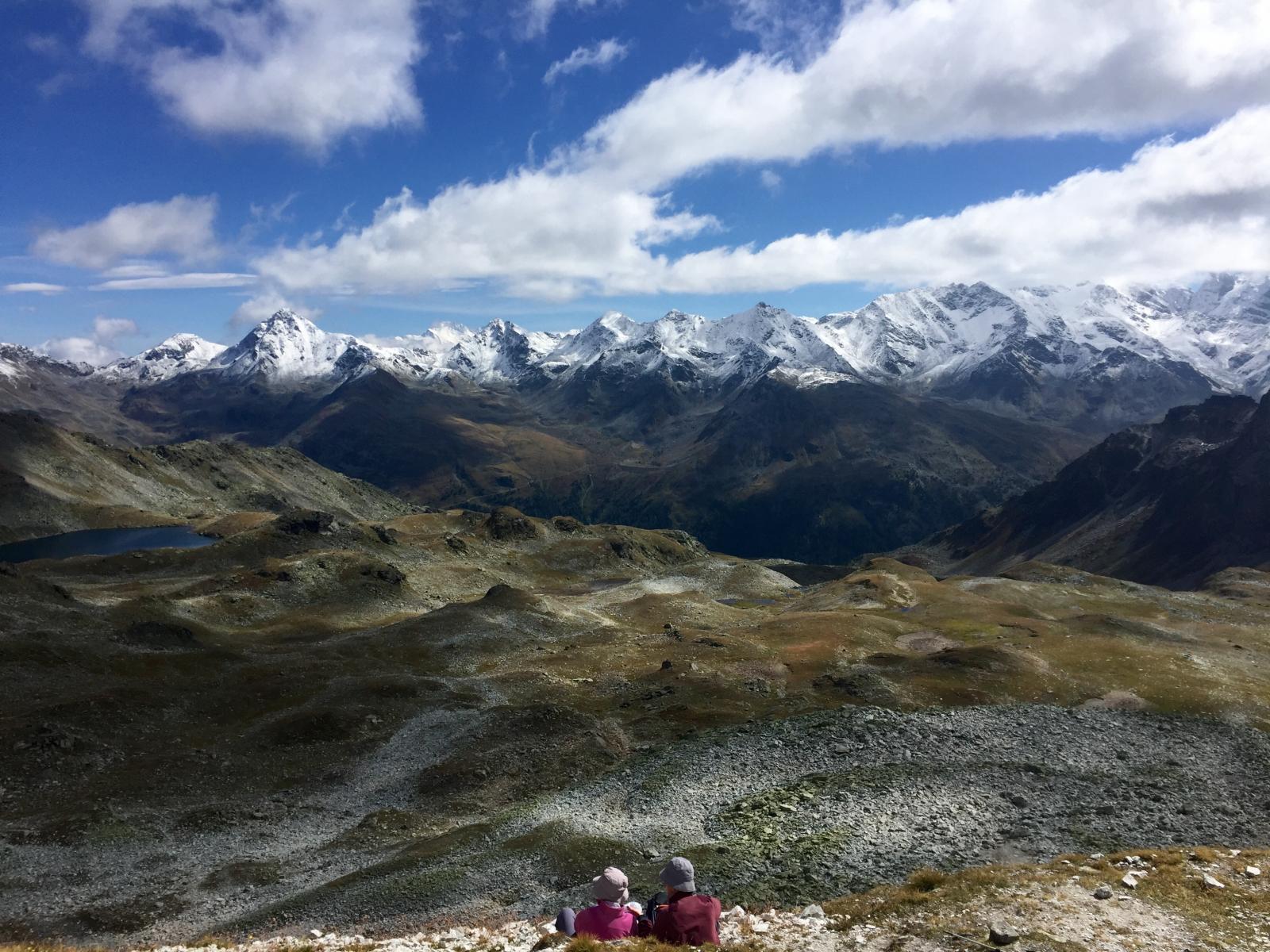
Alpenwild Trip Leaders go out of their way to make sure your trip is enjoyable and successful—everything you want it to be. While not mandatory or obligatory, tips recognizing their efforts are appreciated. The common practice is to hand the tip to the Trip Leaders at the conclusion of the trip. 
Does the Haute Route require technical climbing skills?
No. You'll be benefited from being an experienced hiker, but the entire route can be done without any climbing. There is a little scrambling on the hike from Prafleuri to Arolla on the Chamonix to Zermatt Haute Route. In our experience, there are only a few sections where you regularly place your hand on a rock to steady yourself during a steep ascent or descent. The terrain on the Haute Route is steep, rocky, and rugged in places, but the trail is generally well-marked, groomed, and graded. 
Which Haute Route trips include stays in mountain huts?
On most Haute Route trips, we stay in mountain huts for two consecutive nights, at Louvie and Prafleuri. On the Deluxe Haute Route we skip the huts entirely and stay in small, chalet-style hotels in mountain villages. Huts offer comfortable accommodations and hearty meals in an exquisite alpine setting. Most huts have flush toilets, hot showers, and bedding in a dormitory arrangement. Most of our guests find the atmosphere and location of the huts to be a memorable and distinctly enjoyable part of the trip. 
How many miles do we walk per day?
On the Haute Route, we hike 7-12 miles and gain an average of 3,000 vertical feet per day. On the itinerary for each version of the Haute Route you'll find daily distances and elevation gains spelled out. If you have any questions, call and we can answer specifics about the level of physical activity and skill required for each trip. We are committed to finding the adventure that's right for you. 
What about luggage when we're in the huts?
You will need to plan ahead and carry a few personal items when hiking to the huts, since there are no luggage transfers at the huts. A toothbrush, a change of clothes, a small headlamp, and a dry pair of socks should get you through..jpg)

What is the typical group size?
We keep our group size small-typically between 6 and 12 guests—so that you can receive the highest level of service and attention. Even with as few as 9 guests, we normally have two guides. With additional guides, you'll be able to hike at your own pace and enjoy the route to its fullest. 
What's the difference between walking, hiking and trekking?
The definition varies from one location to another, but generally speaking, "hiking" is just walking outdoors on a natural trail surface. "Trekking" is a hiking journey of several days from one place to another. By that definition, our Haute Route adventures are classic treks, while our Best of the Swiss Alps trip is a wonderful collection of day hikes. By calling and talking with an Alpenwild tour specialist you'll be able to determine which option is best for you. 
Should I purify water on the Haute Route?
Water in the villages and towns throughout the Alps is pure and safe for drinking. Unlike in North America, Giardia is extremely rare in Swiss alpine streams and most guests feel comfortable drinking the water without purifying it. We've never had reports of any problems from drinking it. Still, for your protection, we bring water purification with us which you're always welcome to use. For more information, see our Haute Route Essentials video series which explains this and other topics in greater detail. 
I live in Florida. Will I have a hard time with the altitude?
Most of our hiking in the Swiss Alps is at an elevation between 3,000 and 8,000 feet above sea level. On the Haute Route we cross a pass each day at an elevation nearing 10,000 feet. If you're not used to the altitude, you'll certainly feel the difference. You'll probably feel easily "winded," and may want to take a slower pace initially. At elevations above 8,000 feet you may even notice some nausea, a headache, or loss of appetite. These are normal symptoms of altitude sickness and should disappear as you descend into the valley. 
I've never really done much in the way of strenuous hiking or outdoor adventure. Will I be able to keep up?
Because we keep our group sizes small, we're able to easily adapt to individual needs. On some hikes you may want to take the tram up and hike down or vice versa. At the start of each day we carefully explain the distance, elevation gain, timetable, and options. 
What is the pace for hiking the Haute Route?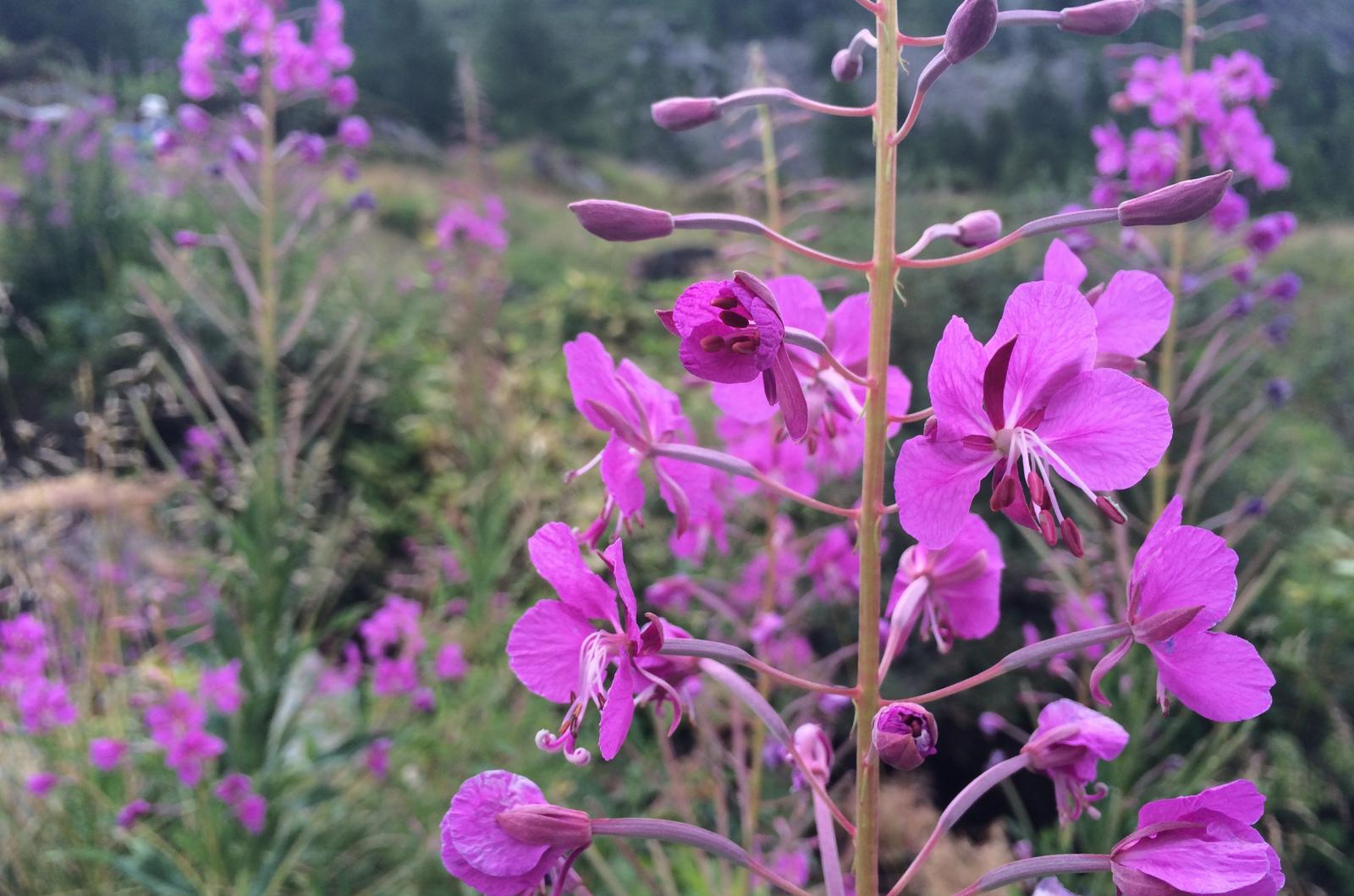
Again, it's very much tailored to the capabilities of the hikers in the group. Since we normally have two guides with each group, we can accommodate a wide range of paces. While we generally stay within close range, faster hikers are free to move at their own pace and wait for the group at a pre-arranged destination. Our Trip Leaders don't rest until all hikers have arrived safely in the village or at the mountain hut. 
What gear do I need to bring? What group gear do you provide?
Prior to departure, we'll provide you with a detailed packing list for hiking and/or for travel, tailored to your adventure, which is also available on our website. You will be responsible for bringing your own clothing, daypack, and other personal outdoor gear such as trekking poles and rain gear. Group gear provided by your Alpenwild trip leader includes a first aid kit, navigational aids (maps, compass, and guides), and trail snacks. 
I'm a vegetarian. Can you accommodate special dietary needs?
Yes. You'll find the Swiss diet is based around dairy products, with a good variety of fresh fruits and vegetables during the summer season. Just let your guide know of your dietary preferences and we should be able to find excellent meals that satisfy your preferences. Even in the huts, you'll find good vegetarian options available. Over the years we have successfully accommodated guests with celiac disease, nut allergies, lactose intolerance, and many other specific allergies. 
Which airport should I fly into for the Haute Route?
If you're starting in Chamonix, fly into Geneva, since Chamonix is just a 90-minute shuttle ride from the Geneva airport, and it's included in your tour price. At the end of the tour when you depart Zermatt, you can go to Zurich, Geneva, or even Milan for your return flight—all three are about the same distance from Zermatt. 
What is a Single Supplement?
The single supplement is an additional charge for someone that is staying by themselves in a single occupancy room. We always calculate our tour prices based on double occupancy rooms. This means that the price of the hotel room is then split between 2 people. However, if only 1 person is in that room, then we need to charge an extra fee to cover the price for the other half of the room. (Example: If a double room = $300 then it would be $150 per person for sharing. That same room would be $300 for the 1 guest, so we would need to charge an extra $150 as a single supplement to cover the price of the whole room).
We try to book double rooms for all our single guests where possible. But some hotels have a true single room and will only give those rooms to our single guest. If this happens, then the price for that single room is usually a little less than a double room. We’ve already factored this into the total price of the single supplement. A solo traveler many not always have the same size room as our guests sharing a room, but be assured that our solo guests are paying for what each hotel has provided for rooms. 


